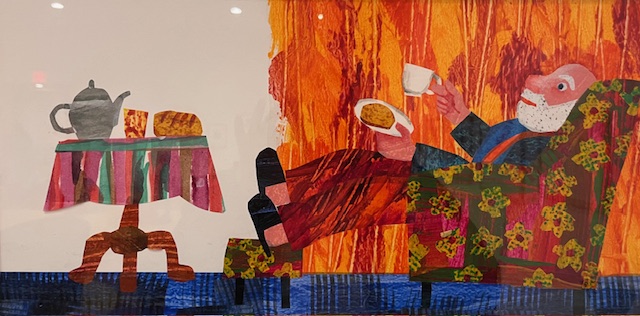Your cart is currently empty!
Eric Carle Museum Displays Imaginative Characters, Experiences

The Eric Carle Museum in Amherst, Massachusetts pays tribute to the illustrator’s prominence in children’s literature. Carle created more than 70 picture books in his signature style – vibrant collage of acrylic painted tissue paper.
Before he became a well-known illustrator, Carle made linoleum prints, or linocuts, which resulted in silhouette-like images. He was commissioned by editor Ann Beneduce in 1965 to create a few linoleum prints for Lila Perl’s cookbook Red-Flannel Hash and Shoo-Fly Pie. Carle grew enthusiastic about the project and created hundreds that were used in almost all of the book’s 285 pages.
The cookbook opportunity proved the beginning of a five decade collaborative partnership between Carle and Beneduce. 1,2,3 to the Zoo marked the first picture book Carle both wrote and illustrated. He admitted to Beneduce his uncertainty about his writing and thus made a wordless picture book. Beneduce loved the combination of an early counting book and an “I spy” game. The Very Hungry Caterpillar emerged as Carle punched holes with a hole puncher. He immediately thought of a bookworm and incorporated hole punches into the design. Beneduce traveled to Japan to find a printer who could mass produce books with holes punched out. Beneduce provided invaluable feedback to Carle throughout the book process. For A House for Hermit Crab, Beneduce praised the lush underwater scenes. For Friends, his correspondence with Beneduce encouraged him to change the main characters from a pair of mice to two human friends.
With each book, Carle and Beneduce traded notes and sketches, writing letters back and forth until they felt satisfied with the result. Carle said of Beneduce, “Ann had the greatest influence on me. We were well-suited for each other.”
For her dedication to his work, Carle gifted artwork to Beneduce. One illustration was from the book Do Bears Have Mothers, Too? By Aileen Fisher. The piece details an adult deer studying a doe lying on a grassy field. The collage hung in the editor’s office for many years, a reminder of her and Carle’s loyal friendship.
The museum also includes the exhibit Free to Be…You and Me: 50 Years of Stories and Songs replete with illustrations, artwork, records, photographs, and newspaper articles. Dress Up is a piece by Audrey Helen Weber that explored possibilities beyond binaries and imagined new kinds of belonging. For “Don’t Dress Your Cat in an Apron” by Dan Greenburg, Tony DiTerlizzi illustrated the poem with watercolor and colored pencil on paper. The artist depicted an adorable, androgynous cat taking off an apron to reveal an eccentric suit. For “We and They” by Lucille Clifton, Jerry Pickney rendered watercolor on paper to depict an imagined world of unity and cooperation crowned by a rainbow.
The gender-bending exhibition flows into the exhibition Created in Color: The Picture Book Art of Raúl Colón. The pieces are grouped into five thematic sections and all display Colón’s distinct style of textured watercolor and colored pencil paintings. Ábrete sésamo! explores how books transcend reality and take us into fantastical worlds. In Bookjoy, Wordjoy by Pat Mora, Colón provided a personality for each poem with fluid lines and glowing colors to capture the joy of sharing stories. Our Journeys dives into the adventures Colón and others experienced throughout the United States. The artist’s work in Child of the Civil Rights Movement by Paula Young Shelton introduced readers to historical moments of activism through the lens of a child.
Their Stories showcases Colón’s talent for bringing biographies to life. In Counting the Stars by Leslie Cline-Ransome, the artist diffused washes of galactic colors on the clothing of NASA mathematician Katherine Johnson. Reading, Writing, and Dreaming depicts Colón’s reimaginings of classic tales. For A Weave of Words by Robert D. San Souci, the illustrator crafted geometric borders and deep red and blue hues found in traditional Armenian textiles. Colorín Colorado evokes Colón’s mastery of cultivating new universes. In Imagine!Colón’s love letter to museums, he utilized vibrant blues, greens, and golds to craft a surreal experience of New York City.
Outside the galleries, the museum contains a makerspace for all ages. The studio encourages patrons to engage with art through open-ended exploration. To complement Carle and Colón’s illustrations, the question posited layering colors. It asked artists to play around with oil pastels, colored pencils, scrapers, and hair combs to manipulate textures and markings. Completed pieces had the opportunity to hang in the sunlit windows.
For more information on the Eric Carle Museum, visit https://carlemuseum.org/.
One response to “Eric Carle Museum Displays Imaginative Characters, Experiences”
Oh I really want to go now!